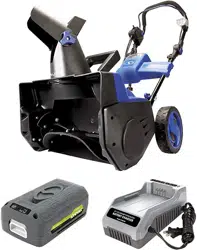Loading ...
Loading ...
Loading ...

4
5. Do not use the supplied battery charger to charge other
cordless tools.
6. During periods of heavy use, the battery pack will become
warm. Allow the battery pack to cool to room temperature
before inserting it into the charger to recharge.
7. Do not overcharge batteries. Do not exceed the maximum
charging times. These charging times only apply to
discharged batteries. Frequent insertion of a charged or
partially charged battery pack will result in overcharging
and cell damage. Do not leave batteries in the charger for
days on end.
8. Never use or charge batteries if you suspect that it has
been more than 12 months since the last time they were
charged. There is a high probability that the battery pack
has already suered dangerous damage (exhaustive
discharge).
9. Charging batteries at a temperature below 50°F (10°C) will
cause chemical damage to the cells and may cause a re.
10. Do not use batteries that have been exposed to heat
during the charging process, as the battery cells may have
suered dangerous damage.
11. Do not use batteries that have suered curvature or
deformation during the charging process or those that
exhibit other atypical symptoms (gassing, hissing,
cracking, etc.)
12. Never fully discharge the battery pack (maximum
recommended depth of discharge is 80%). A complete
discharge of the battery pack will lead to premature aging
of the battery cells.
Protection from environmental
inuences
1. Wear suitable work clothes. Wear safety goggles.
2. Protect your hybrid tool and the battery charger from
moisture and rain. Moisture and rain can cause dangerous
cell damage.
3. Do not use the hybrid tool or the battery charger near
vapors and ammable liquids.
4. Use the battery charger and hybrid tools only in dry
conditions and at an ambient temperature of 50-104°F
(10-40°C).
5. Do not keep the battery charger in places where the
temperature is liable to reach over 104°F (40°C). In
particular, do not leave the battery charger in a car that is
parked in the sunshine.
6. Protect batteries from overheating. Overloads,
overcharging and exposure to direct sunlight will result
in overheating and cell damage. Never charge or work
with batteries that have been overheated – replace them
immediately, if possible.
7. Store the charger and your hybrid tool only in dry locations
with an ambient temperature of 50-104°F
(10-40°C). Store your lithium-ion battery pack in a cool,
dry place at a temperature of 50-68°F (10-20°C). Protect
the battery pack, charger and hybrid tool from humidity
and direct sunlight. Only place fully charged batteries in
storage (charged to at least 40%).
8. Prevent the lithium-ion battery pack from freezing. Battery
packs that were stored below 32°F (0°C) for more than 60
minutes must be discarded.
9. When handling batteries, be wary of electrostatic charge.
Electrostatic discharges can damage the electronic
protection system and the battery cells. Avoid electrostatic
charging and never touch the battery poles.
Electrical Safety
1. Ground fault circuit interrupter (GFCI) protection should
be provided on the circuit(s) or outlet(s) to be used for
the snow blower. Receptacles are available having
built-in GFCI protection and may be used for this
measure of safety.
2. To prevent electric shock, use only with an extension cord
suitable for outdoor use, such as SW-A, SOW-A, STW-A,
STOW-A, SJW-A, SJOW-A, SJTW-A, or SJTOW-A.
Before use, check that the extension cord is in good
condition. When using an extension cord, make sure to
use one heavy enough to carry the current your product
will draw. For lengths less than 50 ft (15 m), a No.14 AWG
(or greater) extension cord should be used. An undersized
cord will cause a drop in line voltage resulting in loss of
power and overheating.
3. To reduce the risk of electric shock, this appliance has
a polarized plug (i.e. one blade is wider than the other).
Use this appliance only with a polarized UL-, CSA-, or
ETL-rated extension cord for outdoor, all-weather use.
The appliance plug will t into a polarized extension
cord only one way.
If the appliance plug does not t fully into the extension
cord, reverse the plug. If the plug still does not t, obtain
a correct polarized extension cord. A polarized extension
cord will require the use of a polarized wall outlet. The
extension cord plug will t into the polarized wall outlet
only one way. If the plug does not t fully into the wall
outlet, reverse the plug. If the plug still does not t,
contact a qualied electrician to install the proper wall
outlet. Do not modify the appliance plug, extension cord
receptacle, or extension cord plug in any way.
Loading ...
Loading ...
Loading ...
